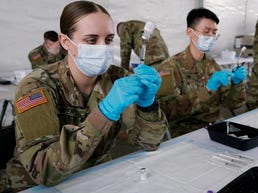
The World Health Organization released a report Tuesday detailing the findings of its review into the origins of the coronavirus that causes COVID-19.
The report is the result of a trip to China taken by a 17-person WHO team from Jan. 14 to Feb. 10. The team collaborated with an equal number of Chinese scientists to explore genetic, epidemiological and animal data from the earliest known days of what became a pandemic.
The 120-page report, produced by the WHO team, offered four possible origin stories for the SARS-CoV-2 virus – ranging from a lab leak to a jump from animals to humans. Rather than offering firm conclusions, it called for further investigation.
A number of countries, including the United States, Canada, Australia, the U.K. and Japan, issued a joint statement Tuesday raising doubts about whether China cooperated adequately with the research process.
The statement "shared concerns that the international expert study on the source of the SARS-CoV-2 virus was significantly delayed and lacked access to complete, original data and samples."
In an open letter March 4, a collection of international scientists called for the global community to insist that China be more forthcoming with data about the early days of the outbreak.
Lawrence Gostin, a global public health law expert at Georgetown University, said China kept global investigators out of the country for a year and didn't conduct or make public any investigation of its own.
Though the United States might also have balked at inviting in a WHO team of investigators, he said, "the difference is the U.S would thoroughly investigate itself and make its results transparent and accountable."
Tedros Adhanom Ghebreyesus, the WHO's director general, agreed more research will be needed, though he struck a more diplomatic tone.
"I do not believe that this assessment was extensive enough. Further data and studies will be needed to reach more robust conclusions," he said Tuesday at a briefing for member states about the report. "This report is a very important beginning, but it is not the end. We have not yet found the source of the virus, and we must continue to follow the science and leave no stone unturned as we do."
USA TODAY tackles five questions addressed by the report:
1. Where did the virus come from?
The WHO team pursued four different possible origin stories for the virus: that it was transmitted directly to humans from animals, probably bats; that it passed through an intermediate animal between bats and humans; that it arrived in Wuhan, China, through the food chain; or that it was the result of a laboratory accident from one of the research laboratories in Wuhan, where the first outbreak was reported.
The team found the most evidence for the second idea – that the virus passed through more than one animal before arriving in humans. Viruses known to have jumped from animals to people, called zoonotic viruses, are extremely common and include Zika, Ebola, West Nile and the flu.
The panel found it "possible" that the food chain was the source of the virus, probably through exposure to frozen wild animal meat imported from elsewhere in China.
Gostin dismissed this theory as "crazy."
"It's biologically plausible, but it's extraordinarily unlikely," he said. "That's not how epidemics arise."
He said he doesn't believe the virus could have originated outside China, as the Chinese government has suggested.
"I don't see how any credible scenario would make the origins arise outside of China. I see no evidence of it," he said. "There's no credible scenario where that's the case."
The team decided that the fourth scenario, a lab leak, was an "extremely unlikely pathway," though it promised to explore any information that becomes available.
The WHO's Tedros, a biologist and public health expert, said he isn't ready to dismiss the possibility.
"Although the team has concluded that a laboratory leak is the least likely hypothesis, this requires further investigation, potentially with additional missions involving specialist experts, which I am ready to deploy," Tedros said in his briefing to WHO member nations. "Let me say clearly that as far as WHO is concerned, all hypotheses remain on the table."
2. Why did the team find it unlikely the virus came from a lab leak?
When the virus first gained global attention in January 2020, many people thought it must have been accidentally released from a research lab, the WHO's team leader, Peter Ben Embarek, a Danish food safety and zoonosis expert, said Tuesday in a news conference.
Even the staff members at research labs in Wuhan wondered at first if their labs, some of which studied viruses from the same coronavirus family as SARS-CoV-2, were to blame, he said.
Extensive research provided no evidence of a leak, and the team considered lots of other leads more promising.
"Lab accidents do happen once in a while," Ben Embarek said, so it certainly could have happened in this case.
"But nobody could find any trace of something similar to this virus in their records or their samples," he continued. "Apart from that idea that there is a lab nearby or several labs nearby in the same city, so there must be a link – apart from that, nobody has been able to pick up any firm arguments or proof of evidence that any of these labs would have been involved in a lab leak or accident."
In addition to speaking with lab workers and examining lab data, the team reviewed blood samples that are routinely taken from staff members in labs that work with viruses – and found no evidence that they had been exposed early in the outbreak.
"We were satisfied that there was no obvious evidence of a problem and that people had done the appropriate look-back to see how the laboratory had been functioning during that time," said team member Dominic Dwyer, an Australian microbiologist and clinical professor of medicine at the University of Sydney's School of Medicine.
The team did not complete a "true forensic" examination of the laboratory to check for leaks. "That's not what we were there to do," Dwyer said.
Critics of the WHO study said the team was too focused on zoonotic sources of the virus, lacked the skills to investigate a lab breach or accident and relied on verbal assurances from Chinese officials.
Considering the lab leak as a possibility, Dr. Tom Frieden, former director of the Centers for Disease Control and Prevention, said in an interview that the report should be a call to action to improve lab safety.
Frieden said there have been far too many accidents and near misses at labs across the world. In the late 1970s, he said, the Soviet Union may have accidentally released a flu virus that spread globally. In the same era, a smallpox infection killed a lab worker in the U.K. The SARS virus escaped from a lab in 2004 and killed one person. And under his own watch at the CDC, there were several near misses, he said.
"Regardless of what happened in China or did not happen in China, we need safer laboratories," he said.
3. Why is the animal route considered the most likely?
Most scientists say the virus probably arose in animals and jumped into humans, because that's happened many, many times before.
Rabies transmits from an animal bite. Simian immunodeficiency virus first arose in monkeys before transforming into HIV. Ebola is believed to come from wild animals, perhaps from eating bush meat.
Similar viruses to SARS-CoV-2 – severe acute respiratory syndrome and Middle East Respiratory Syndrome – are known to have jumped from animals. In the case of SARS, the virus is believed to have arrived in humans via bats, then civets; for MERS, camels are the intermediary, though it probably emerged in bats, too.
The team examined 80,000 samples from wildlife, livestock and poultry across China and 900 swabs from the seafood market where the first outbreak was known to have occurred, but it found no telltale signatures of the SARS-CoV-2 virus.
"What we do see are some clear links, some clear pathways this virus could have taken," said Peter Daszak, a team member, zoonosis expert and president of EcoHealth Alliance, a nonprofit group that supports global health and pandemic prevention.
"Our understanding of the events in Wuhan began to fit together when we looked at the molecular data, the epi data and the animal data. It all seemed to fit to form a big-picture and story about what might be happening," he said.
Still, more information is needed, which Daszak said he expects the Chinese government to provide.
The report mentioned the need for further investigation into the first 174 human cases detected in Wuhan in December 2019, as well as "environmental sampling from markets and farms in areas where the first human cases were identified, and detailed records on the source and type of wildlife species and farmed animals sold in these markets."
4. When did the outbreak begin?
Without knowing exactly what sparked the outbreak, it's impossible to know precisely when it started.
Many people infected with SARS-CoV-2 do not show symptoms, so it was only in late December, when there was a cluster of people who ended up sick enough to be hospitalized, that the Chinese noticed the outbreak.
There was no uptick in related illnesses before that time nor an increase in drugstore purchases of fever reducers or cough or cold medicines, the researchers found.
Genetic data suggested the first cases could have come as early as September, though more likely between mid-November and early December.
The Chinese government has pointed to small amounts of evidence suggesting the virus started in another country earlier in the year and arrived in China in December, but the report did not add much support to that idea.
"All the published genetic sequences of SARS-CoV-2 isolated from human cases are very similar, suggesting that the start of the outbreak resulted from a single point introduction in the human population around the time that the virus was first reported in humans in Wuhan, China," the report found.
5. Did the Chinese interfere with the investigation?
Ben Embarek said the Chinese government, like many others, put pressure on the team as it conducted its work.
"Of course, there was political pressure from all sides, also outside China," he said. "But I think we were able to create a space for the science, a space for the two groups of scientists that worked together. We had nothing to hide. So there was no problem working in an open environment and sharing our work and our discussions as we had them."
In their joint statement Tuesday, 14 countries raised questions about how forthcoming China has been.
"Together, we support a transparent and independent analysis and evaluation, free from interference and undue influence, of the origins of the COVID-19 pandemic," the statement begins. "In this regard, we join in expressing shared concerns regarding the recent WHO-convened study in China, while at the same time reinforcing the importance of working together toward the development and use of a swift, effective, transparent, science-based, and independent process for international evaluations of such outbreaks of unknown origin in the future."
Gostin said the team was like a police investigator barred from a crime scene.
"China has literally managed the WHO experts: has told them what they can see, what they can't see, when they can see it, and there's credible evidence that they were involved in reviewing, if not strongly influencing, the report," he said. "The report didn't indicate to me how the WHO is going to gain access to the kind of independent sources that it needs when it hasn't been able to for over a year."
The report, though useful, didn't add much that was novel, Gostin said. "We haven't really learned anything in a year."
The team members were unanimous in their findings, Ben Embarek said, including in the idea that this report is just the first of a number of investigations into the origins of the virus.
They all agree it's essential to learn more about the virus's origins to prevent another pandemic.
"If we don't look into what happened, don't understand what happened, most certainly, we will again face something similar in the future," he said.
Contact Karen Weintraub at [email protected].
Health and patient safety coverage at USA TODAY is made possible in part by a grant from the Masimo Foundation for Ethics, Innovation and Competition in Healthcare. The Masimo Foundation does not provide editorial input.
Source link









